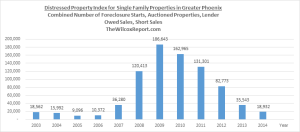What really happens on August 1, 2015?
June 10, 2015 Scottsdale Area Association of REALTORS
Saturday, August 1, 2015 will seem just like any other hot summer day in Scottsdale. But starting on August 1, any loan application completed that day or thereafter, will be under the new CFPB rules. These new rules create new documents and change the residential closing process.
Even though the new rules are effective August 1, we will not know many of their effects on the closing process until September, because most contracts written in August involving a loan will not close until sometime in September. But until then, there are many things real estate agents can learn about the new rules that will help them in preparing for the new closing process.
What percentage of residential closings will be effected by the new rules? If the new rules had been in effect in May 2015, 76% or 5,627 of the 7,398 ARMLS residential closings in Maricopa County would have been affected. 76% is the number of closings in which a buyer purchased a property with either a conventional, FHA, VA or FMHA loan. All these loan types fall under the August 1 rules. Two loan types that are not included under the new rules are reverse mortgages, and home equity lines of credit also known as HELOCS. The new rules do not apply to a cash transaction.
So what are the new documents and how is the closing process changed?
The Good Faith Estimate and the initial Truth in Lending will be replaced by the Loan Estimate. The HUD-1 Settlement Statement and final Truth in Lending will be replaced by the Closing Disclosure.
The emphasis of this article is the effect of the Closing Disclosure. The Closing Disclosure has a timeline associated with it. Before the borrower can sign loan documents, they must have the Closing Disclosure three business days in order to review it. These three days are called the Waiting Period.
Let’s do a scenario. According to line 73 of the Arizona Association of REALTORS® (AAR) Residential Resale Real Estate Purchase Contract the borrower is to sign loan documents three (full) days before the close of escrow date. So if the close of escrow is a Friday, the borrower is to sign loan documents on the preceding Monday. If the borrower is to have the Closing Disclosure three business days before signing the loan documents, the Closing Disclosure is to be delivered no later than the preceding Thursday. So in this scenario the Closing Disclosure has to be received eight days before the close of escrow date.
| Thursday | Friday | Saturday | Sunday | Monday | Tuesday | Wednesday | Thursday | Friday |
| Closing Disclosure received.Day one of waiting period. | Day two of waiting period. | Day three of waiting period. | Sign loan documents | COE |
Before the Waiting Period begins, there are specific rules in how the Closing Disclosure may be delivered. Depending on the delivery method (email, regular mail, hand delivered), additional days may be added to the above timeline before the Waiting Period begins. Lenders are responsible for both the preparation and delivery of the Closing Disclosure to the buyer. Currently the HUD-1 Settlement Statement is prepared and presented by the escrow company. This process ends for loan applications taken on or after August 1, 2015.
What are others saying how the Closing Disclosure and its timeline may affect the closing process?
Below are two links to videos produced by the National Association of REALTORS®. I suggest you watch both for knowledge and understanding.
In the first video, it is suggested to add fifteen days to the closing time. If you usually write a thirty day close of escrow when the buyer is purchasing with a loan you may want to extend that to a forty five day close of escrow. Also suggested is that you make sure your clients are ready seven days prior to closing, and make sure that sellers abide by their agreements. I believe these are suggested because you don’t want last minute changes or negotiations that may kick in a new Closing Disclosure – with a new three day waiting period – thus delaying the closing. Note: A new Closing Disclosure doesn’t automatically mean there will be a new Waiting Period. An additional three day waiting period is required if the APR changes by 1/8% for a fixed rate mortgage. So if your clients do something toward the end of the transaction that changes the APR there may be an additional three days before closing. Adding a prepayment penalty or a change in the loan type also adds an additional three days.
http://www.realtor.org/videos/hud-1-going-away-understand-new-closing-forms-procedures
The second video mentions the need to educate your clients that transactions will likely take longer if the buyer is purchasing with a mortgage, and has other takeaways for real estate agents.
http://www.realtor.org/topics/trid-tila-respa-integrated-disclosure
It is my opinion that once we see the effects of the new rules, some agents will add contract language to the contract to address the new process and to protect their clients. It is also my opinion that the process will be much smoother for those real estate agents, lenders and escrow companies that spend the time, now, learning the changes.
Fletcher R. Wilcox recently had added to his job description the title CFPB External Operations Expert at Grand Canyon Title Agency. He is meeting with lenders and real estate agents and discussing how the closing process may be improved amongst them and escrow when the new rules take effect. Grand Canyon Title is a wholly owned subsidiary of the Fortune 316 Company FNF. All the local FNF brands in Arizona are working together in unity in presenting how they will be ready and prepared for August 1, 2015.
Fletcher is the author of www.TheWilcoxReport.com. His market analysis on residential real estate in Greater Phoenix has been mentioned in the Wall Street Journal, Bloomberg News, HousingWire.com and National Mortgage News. He has been a guest speaker on both local and national TV and radio.
– See more at: http://www.saaronline.com/news/2015/06/10/what-really-happens-on-august-1-2015#sthash.LbCWIGx4.dpuf






Follow Fletcher